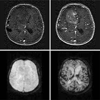Revision of the theory of tracer transport and the convolution model of dynamic contrast enhanced magnetic resonance imaging
- PMID: 17429633
- PMCID: PMC3986025
- DOI: 10.1007/s00285-007-0089-3
Revision of the theory of tracer transport and the convolution model of dynamic contrast enhanced magnetic resonance imaging
Abstract
Counterexamples are used to motivate the revision of the established theory of tracer transport. Then dynamic contrast enhanced magnetic resonance imaging in particular is conceptualized in terms of a fully distributed convection-diffusion model from which a widely used convolution model is derived using, alternatively, compartmental discretizations or semigroup theory. On this basis, applications and limitations of the convolution model are identified. For instance, it is proved that perfusion and tissue exchange states cannot be identified on the basis of a single convolution equation alone. Yet under certain assumptions, particularly that flux is purely convective at the boundary of a tissue region, physiological parameters such as mean transit time, effective volume fraction, and volumetric flow rate per unit tissue volume can be deduced from the kernel.
Figures





References
-
- Ash RB. Real Analysis and Probability. New York: Academic; 1972.
-
- Banks HT, Kareiva P. Parameter estimation techniques for transport equations with application to population dispersal and tissue bulk flow models. J. Math. Biol. 1983;17:253–273. - PubMed
-
- Banks HT, Kunisch K. Estimation Techniques for Distributed Parameter Systems. Boston: Birkhäuser; 1989.
-
- Batchelor GK. An Introduction to Fluid Dynamics. Cambridge: Cambridge University Press; 1990.
-
- Calamante F, Gadian DG, Connelly A. Quantification of bolus tracking MRI: improved characterization of the tissue residue function using Tikhonov regularisation. Magn. Reson. Med. 2003;50(6):1237–1247. - PubMed
MeSH terms
Substances
Grants and funding
LinkOut - more resources
Full Text Sources
Other Literature Sources

